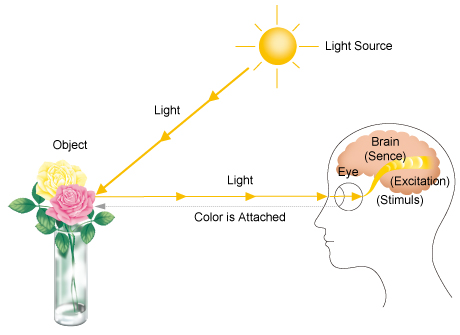Commonly, when we turn our gaze on an object, it is seen as if the object has the color (See the dotted line in Figure 6). But if we are in darkness or there is nothing in view, we can't perceive the object. In addition, we can't perceive the color with eyes closed. As the color is phenomenon which is perceived by illuminated light source, an object and human eyes, we can understand the color in the following definitional sequence.
(1) Due to the difference of the spectrum composition that enters eyes, The color is the aspect of visual perception where difference of quality is admitted.
(2) The color is one of special qualities for light because the visual perception arise from the light quality.
(3) The color is one of special qualities for the object because the light arises from the reflection and transmittance from illuminated object.
In other words, as with Figure 6, the color can be numerically expressed, if you understand the correspondence relation between light and color sense, because the color depends on both the light special quality which appear from the light source and the special quality of an object which reflects and transmit the light. This is fundamental rule for color measurement. The features for illuminated light source, the measurement way for the object which has the features of reflectance and transmittance and the eye's sensitivity to the light are standardized on CIE and ISO respectively.

